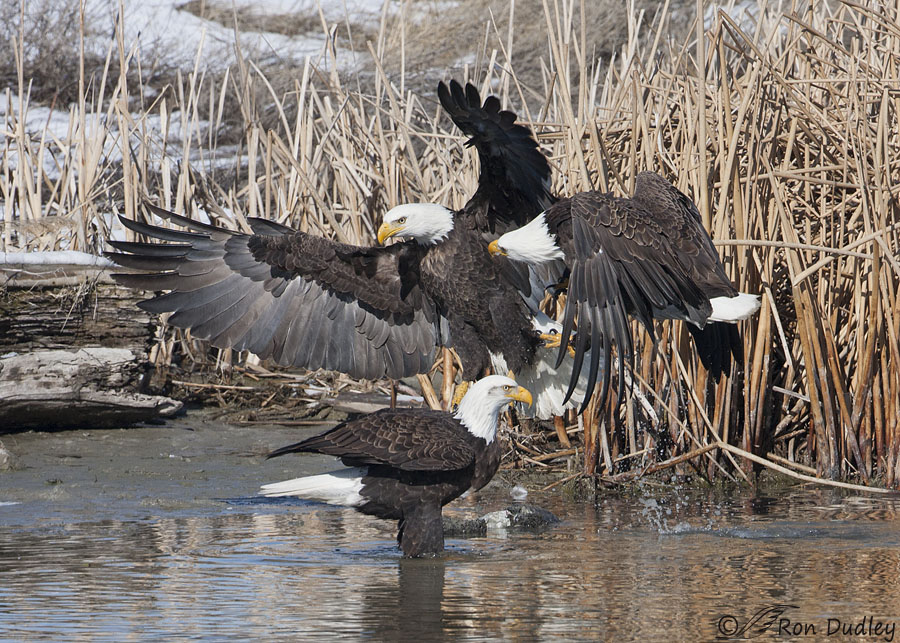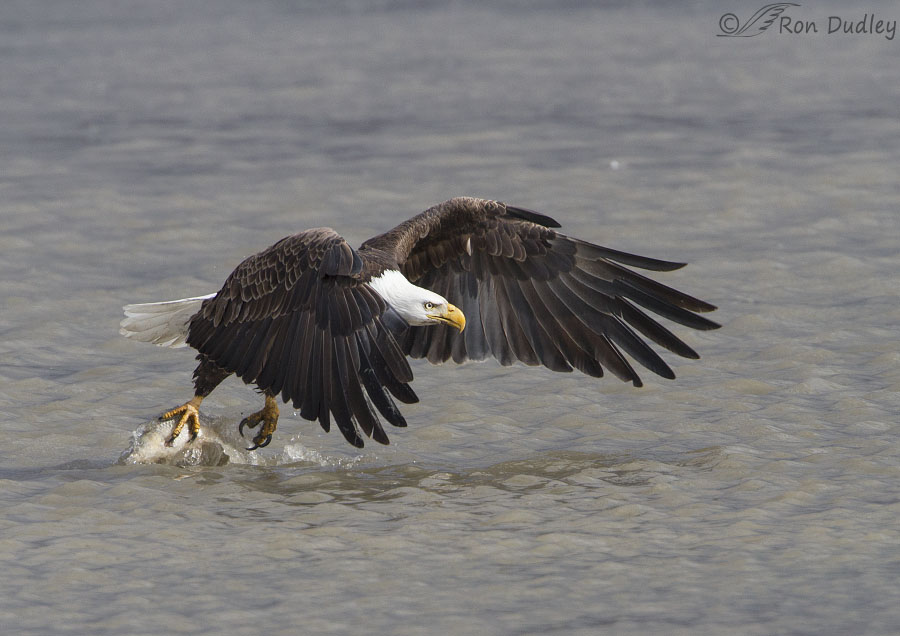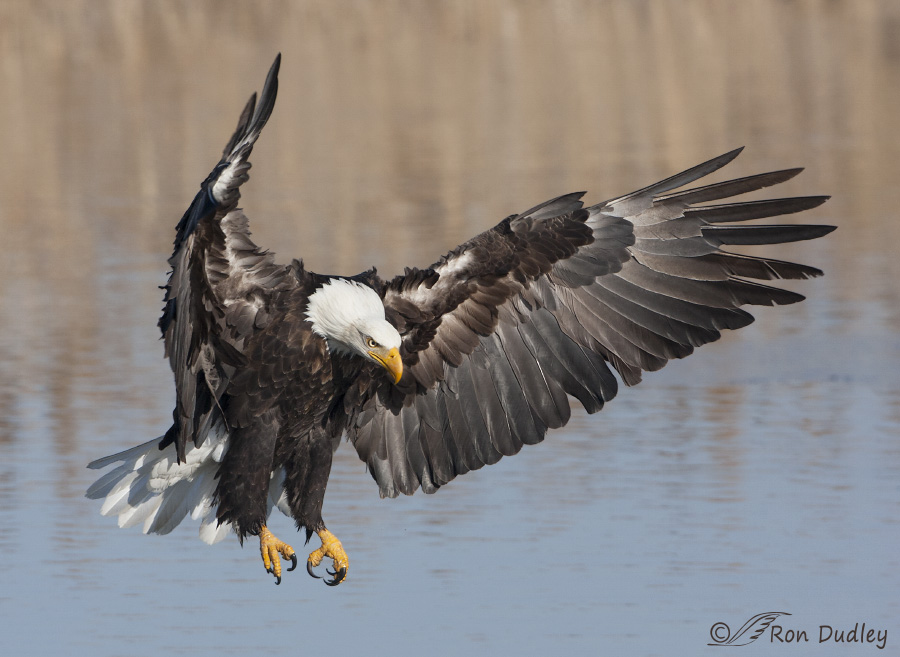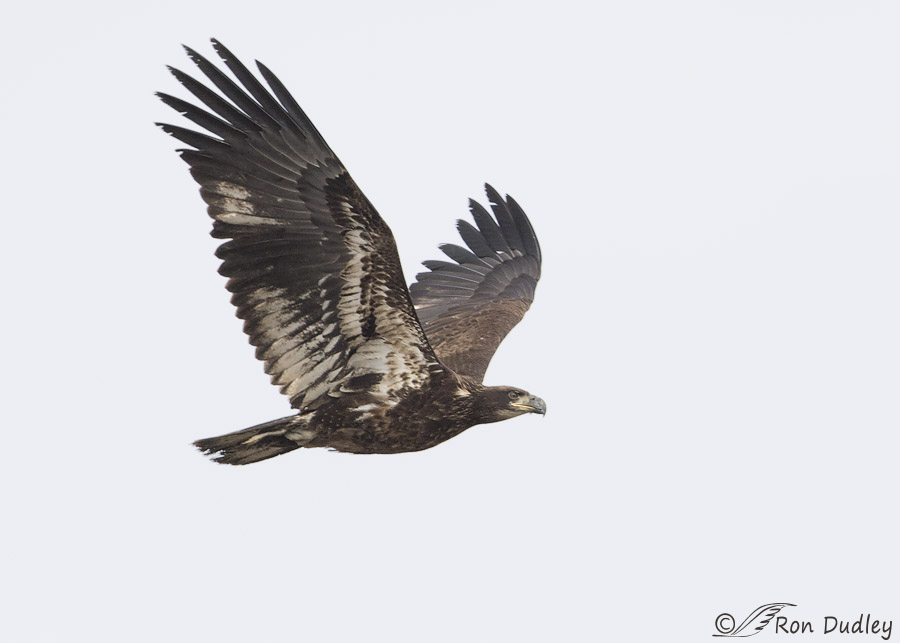Tag: rotenone
Bald Eagle Snagging A Fish Out Of Water
A Bald Eagle From My Archives (and some thoughts on baiting)
Farmington Bald Eagle Update
Farmington Bay, Bald Eagles And The 2014 Carp Kill
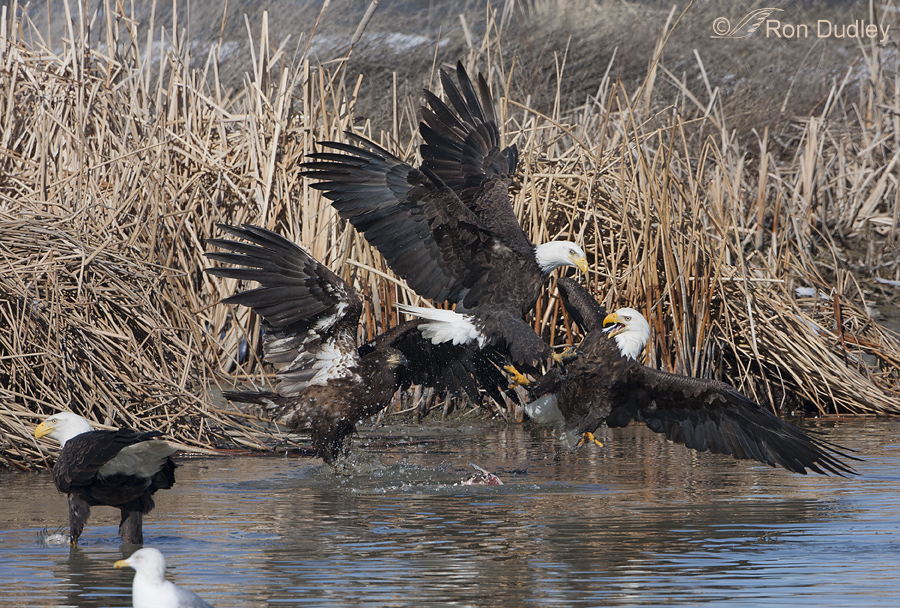
For years managers at Farmington Bay WMA have killed carp as a management tool. The dead fish bring in hundreds of Bald Eagles but this year, because of the West Nile Virus outbreak in the eagle population, managers had to decide whether or not to proceed with the fish kill. That decision has been made.
Just A Shot That I Like… #29 – Adult Bald Eagle In Flight
Bald Eagles are a winter tradition in northern Utah. Many hundreds of northern birds spend the winter here and for much of that time they’re dispersed over wide areas looking for easy pickings – carrion in particular. But when concentrated food sources become available they can occasionally be found in large numbers. 1/4000, f/8, ISO 500, 500 f/4, natural light This sometimes happens at Farmington Bay Waterfowl Management Area when refuge personnel treat the ponds with rotenone to kill the damaging and invasive carp. When conditions are right, Bald Eagles congregate there for the carp feast. This bird was cruising the area around the second bridge looking for fish. Some years, when temperatures are frigid and other food sources are unavailable, provide great opportunities for birders and photographers but last year wasn’t one of them. The winter was warm and food was available elsewhere so the eagle numbers were down significantly. It will be interesting to see what happens over the next few weeks… Ron
Farmington Bay Bald Eagles 2012 – A Bust!
Farmington Bay Wildlife Management Area is typically a mecca for birders and bird photographers during January and February. When it gets very cold many of Utah’s wintering Bald Eagles congregate there and create quite the spectacle for avian enthusiasts. Though I’m not particularly fond of photographing birds among throngs of people I usually can’t resist the unusual opportunity with these magnificent birds and join in the fray multiple times during the “season”. 1/1250, f/7.1, ISO 500, 500 f/4, 1.4 tc One thing that especially appeals to me about Farmington Bay is the opportunity to photograph these eagles in flight with the Wasatch Mountains as a background. Even though such a background makes it much more difficult for focus to “lock on” the bird I really like the dramatic backdrop the dark, often shaded mountains provide when there’s light on the eagle – much more appealing for me than the typical blue sky background. Typically there are hundreds of eagles at the refuge during “prime time”. I once counted 225 birds and that’s just the ones I could see. Others have reported from 300-400 birds. This photo should give you some idea, though it shows just one small portion of Unit One. The concentration of birds was about the same that day everywhere you looked over the ice. This is the famous “eagle tree”. I’ve seen as many as 20 birds on this one perch alone. Of course the eagles prefer to look south over the ice and water so it’s difficult…
Bald Eagles at Farmington Bay
I paid another visit to Farmington yesterday and while I got some nice shots of a few other species I was reminded of the Bald Eagles that were winter residents out there just a few short months ago. I miss them. So when it turned overcast this morning and I couldn’t go out photographing birds I decided to revisit some of the eagle images I got at Farmington three months ago. Canon 7D, 1/2500, f/7.1, ISO 500, 500 f/4, 1.4 tc This carp may have been an easy catch for the eagle because the water was quite shallow and the fish was likely stunned (though it did appear to still be alive) by the rotenone used to control these fish at the refuge. Canon 7D, 1/2500, f/7.1, ISO 500, 500 f/4, 1.4 tc Both of these images of the eagle with the fish were difficult exposures with the white head facing toward the sun but I liked the action and the good look at the carp. Canon 7D, 1/2000, f/6.3, ISO 500, 500 f/4, 1.4 tc This is one of my better exposures on both the white head and the very dark body and wing plumage in the species. Early morning light certainly helped with that exposure. Canon 7D, 1/1250, f/6.3, ISO 500, 500 f/4, 1.4 tc I like the unusual head turn from this juvenile bird and the Wasatch Mountain background. Canon 7D, 1/4000, f/6.3, ISO 640, 500 f/4, 1.4 tc (wish I’d had lower ISO in this image…
Fish Eating Northern Harriers
As I’ve mentioned before in this blog, the winter of 2008 was a particularly brutal one in northern Utah. During January and February there was much more snow than usual and it was bitterly cold. During most winters our Northern Harriers rely primarily on voles as a food supply but in 2008 with the voles under the deep crusty snow our harriers were desperate for food. Birds of North America Online provides extensive information on the dietary habits of harriers. It lists small to medium-sized mammals (primarily rodents), birds, reptiles and frogs as harrier food sources, stating further that the diet of harriers during winter in their northern range (which includes northern Utah) consists of voles “almost exclusively”. I can find no mention of harriers eating fish, ever! Each year in early February some of our wetlands managers treat some of our ponds with rotenone (a chemical that prevents oxygen from being absorbed across fish gill membranes) in an effort to control the invasive and damaging carp that do so much damage to the emergent vegetation which is so vital for waterfowl. So, in 2008 for a few weeks, our desperate and starving harriers began to eat fish! In the three winters since then I have never seen harriers eating fish even though the dead carp are always plentiful after the rotenone kill. 1/1250, 1/1000, ISO 500 Many of the carp are brought to the shores or ice surface by Bald Eagles which makes them available to the harriers who generally cannot retrieve them from the water. 1/1250, f/8, ISO…
Bald Eagle Eating a Fish in Mid-air
I’ve often seen Bald Eagles carrying fish but never one actually consuming the meal while flying. Until yesterday, when I got some photos of the behavior. Thanks to Mia for calling my attention to it or I may have missed the whole thing. Eating carp in flight At first I wondered if this eagle was only killing the carp with a lethal bite as I have seen other raptors do in-flight, but then I remembered that it was already dead when it was picked up by the eagle. These fish were killed by refuge personnel (they use rotenone) in order to prevent damage to the wetlands done by these invasive fish. Falling fish scales The four photos in this sequence are in the order that they happened. Here you can see scales and debris falling from the carp as the eagles very sharp bill does its damage. Part of the head, including gill flap (operculum) being torn off I suspect that the reason this eagle chose to consume at least part of its meal in flight has to do with competition. There weren’t many fish available and lots of hungry gulls and eagles to squabble over them. If an eagle tried to eat a fish on the ice (the ponds were mostly frozen) other birds would usually challenge them for the meal. Even gulls were at times very aggressive toward the eagles. On several occasions I observed gulls biting the tails of the eagles while both were in flight. Perhaps this eagle figured it had…
Bald Eagles in Utah
Every winter hundreds of Bald Eagles migrate south from Canada and Alaska and winter in Utah. They do so because of our relatively mild winters and they are able to find sufficient food here. Typically they begin arriving in November and leave in March when the ice begins to melt. They can be found in many areas of the state but a large percentage of them winter on the wetlands surrounding the Great Salt Lake where there are a number of bird refuges and other suitable areas to accommodate them. Adult Bald Eagle in flight Each year I spend many hours at some of the Great Salt Lake wetlands photographing eagles. What attracts them to some of the refuges is fish – lots of fish, especially carp. Carp are a nuissance for wildlife managers because they root in the mud of the shallow impoundments which makes the water cloudy and unable to transmit light to the bottom. This disrupts the healthy growth of desirable plant species needed by birds so some refuges “poison” the carp, usually in mid-winter, with rotenone – a non-toxic chemical that forms a film on fish gills preventing oxygen transfer from the water to the blood which kills the carp. Then it’s feast time for the eagles. Bald Eagles and gulls on the ice It’s common to see several hundred Bald Eagles from one spot. One refuge counted 408 eagles. I’ve personally seen 150 – 200 birds on several occasions. Immature Bald Eagle with carp This is why they’re here – fish! Specifically, carp. Lots of carp…
Bald Eagle Snagging A Fish Out Of Water
A Bald Eagle From My Archives (and some thoughts on baiting)
Farmington Bald Eagle Update
Farmington Bay, Bald Eagles And The 2014 Carp Kill

For years managers at Farmington Bay WMA have killed carp as a management tool. The dead fish bring in hundreds of Bald Eagles but this year, because of the West Nile Virus outbreak in the eagle population, managers had to decide whether or not to proceed with the fish kill. That decision has been made.
Just A Shot That I Like… #29 – Adult Bald Eagle In Flight
Bald Eagles are a winter tradition in northern Utah. Many hundreds of northern birds spend the winter here and for much of that time they’re dispersed over wide areas looking for easy pickings – carrion in particular. But when concentrated food sources become available they can occasionally be found in large numbers. 1/4000, f/8, ISO 500, 500 f/4, natural light This sometimes happens at Farmington Bay Waterfowl Management Area when refuge personnel treat the ponds with rotenone to kill the damaging and invasive carp. When conditions are right, Bald Eagles congregate there for the carp feast. This bird was cruising the area around the second bridge looking for fish. Some years, when temperatures are frigid and other food sources are unavailable, provide great opportunities for birders and photographers but last year wasn’t one of them. The winter was warm and food was available elsewhere so the eagle numbers were down significantly. It will be interesting to see what happens over the next few weeks… Ron
Farmington Bay Bald Eagles 2012 – A Bust!
Farmington Bay Wildlife Management Area is typically a mecca for birders and bird photographers during January and February. When it gets very cold many of Utah’s wintering Bald Eagles congregate there and create quite the spectacle for avian enthusiasts. Though I’m not particularly fond of photographing birds among throngs of people I usually can’t resist the unusual opportunity with these magnificent birds and join in the fray multiple times during the “season”. 1/1250, f/7.1, ISO 500, 500 f/4, 1.4 tc One thing that especially appeals to me about Farmington Bay is the opportunity to photograph these eagles in flight with the Wasatch Mountains as a background. Even though such a background makes it much more difficult for focus to “lock on” the bird I really like the dramatic backdrop the dark, often shaded mountains provide when there’s light on the eagle – much more appealing for me than the typical blue sky background. Typically there are hundreds of eagles at the refuge during “prime time”. I once counted 225 birds and that’s just the ones I could see. Others have reported from 300-400 birds. This photo should give you some idea, though it shows just one small portion of Unit One. The concentration of birds was about the same that day everywhere you looked over the ice. This is the famous “eagle tree”. I’ve seen as many as 20 birds on this one perch alone. Of course the eagles prefer to look south over the ice and water so it’s difficult…
Bald Eagles at Farmington Bay
I paid another visit to Farmington yesterday and while I got some nice shots of a few other species I was reminded of the Bald Eagles that were winter residents out there just a few short months ago. I miss them. So when it turned overcast this morning and I couldn’t go out photographing birds I decided to revisit some of the eagle images I got at Farmington three months ago. Canon 7D, 1/2500, f/7.1, ISO 500, 500 f/4, 1.4 tc This carp may have been an easy catch for the eagle because the water was quite shallow and the fish was likely stunned (though it did appear to still be alive) by the rotenone used to control these fish at the refuge. Canon 7D, 1/2500, f/7.1, ISO 500, 500 f/4, 1.4 tc Both of these images of the eagle with the fish were difficult exposures with the white head facing toward the sun but I liked the action and the good look at the carp. Canon 7D, 1/2000, f/6.3, ISO 500, 500 f/4, 1.4 tc This is one of my better exposures on both the white head and the very dark body and wing plumage in the species. Early morning light certainly helped with that exposure. Canon 7D, 1/1250, f/6.3, ISO 500, 500 f/4, 1.4 tc I like the unusual head turn from this juvenile bird and the Wasatch Mountain background. Canon 7D, 1/4000, f/6.3, ISO 640, 500 f/4, 1.4 tc (wish I’d had lower ISO in this image…
Fish Eating Northern Harriers
As I’ve mentioned before in this blog, the winter of 2008 was a particularly brutal one in northern Utah. During January and February there was much more snow than usual and it was bitterly cold. During most winters our Northern Harriers rely primarily on voles as a food supply but in 2008 with the voles under the deep crusty snow our harriers were desperate for food. Birds of North America Online provides extensive information on the dietary habits of harriers. It lists small to medium-sized mammals (primarily rodents), birds, reptiles and frogs as harrier food sources, stating further that the diet of harriers during winter in their northern range (which includes northern Utah) consists of voles “almost exclusively”. I can find no mention of harriers eating fish, ever! Each year in early February some of our wetlands managers treat some of our ponds with rotenone (a chemical that prevents oxygen from being absorbed across fish gill membranes) in an effort to control the invasive and damaging carp that do so much damage to the emergent vegetation which is so vital for waterfowl. So, in 2008 for a few weeks, our desperate and starving harriers began to eat fish! In the three winters since then I have never seen harriers eating fish even though the dead carp are always plentiful after the rotenone kill. 1/1250, 1/1000, ISO 500 Many of the carp are brought to the shores or ice surface by Bald Eagles which makes them available to the harriers who generally cannot retrieve them from the water. 1/1250, f/8, ISO…
Bald Eagle Eating a Fish in Mid-air
I’ve often seen Bald Eagles carrying fish but never one actually consuming the meal while flying. Until yesterday, when I got some photos of the behavior. Thanks to Mia for calling my attention to it or I may have missed the whole thing. Eating carp in flight At first I wondered if this eagle was only killing the carp with a lethal bite as I have seen other raptors do in-flight, but then I remembered that it was already dead when it was picked up by the eagle. These fish were killed by refuge personnel (they use rotenone) in order to prevent damage to the wetlands done by these invasive fish. Falling fish scales The four photos in this sequence are in the order that they happened. Here you can see scales and debris falling from the carp as the eagles very sharp bill does its damage. Part of the head, including gill flap (operculum) being torn off I suspect that the reason this eagle chose to consume at least part of its meal in flight has to do with competition. There weren’t many fish available and lots of hungry gulls and eagles to squabble over them. If an eagle tried to eat a fish on the ice (the ponds were mostly frozen) other birds would usually challenge them for the meal. Even gulls were at times very aggressive toward the eagles. On several occasions I observed gulls biting the tails of the eagles while both were in flight. Perhaps this eagle figured it had…
Bald Eagles in Utah
Every winter hundreds of Bald Eagles migrate south from Canada and Alaska and winter in Utah. They do so because of our relatively mild winters and they are able to find sufficient food here. Typically they begin arriving in November and leave in March when the ice begins to melt. They can be found in many areas of the state but a large percentage of them winter on the wetlands surrounding the Great Salt Lake where there are a number of bird refuges and other suitable areas to accommodate them. Adult Bald Eagle in flight Each year I spend many hours at some of the Great Salt Lake wetlands photographing eagles. What attracts them to some of the refuges is fish – lots of fish, especially carp. Carp are a nuissance for wildlife managers because they root in the mud of the shallow impoundments which makes the water cloudy and unable to transmit light to the bottom. This disrupts the healthy growth of desirable plant species needed by birds so some refuges “poison” the carp, usually in mid-winter, with rotenone – a non-toxic chemical that forms a film on fish gills preventing oxygen transfer from the water to the blood which kills the carp. Then it’s feast time for the eagles. Bald Eagles and gulls on the ice It’s common to see several hundred Bald Eagles from one spot. One refuge counted 408 eagles. I’ve personally seen 150 – 200 birds on several occasions. Immature Bald Eagle with carp This is why they’re here – fish! Specifically, carp. Lots of carp…


